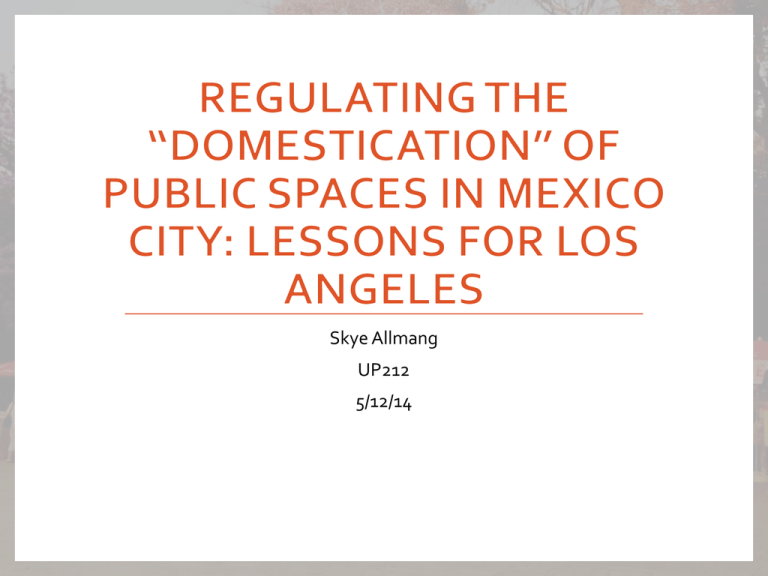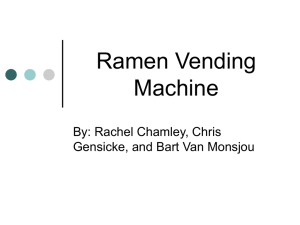Regulating the “Domestication” of Public Spaces in Mexico City
advertisement

Skye Allmang UP212 5/12/14 Overview • Background • Informal street vending in Mexico City • Mexico City’s integration program for informal subway vendors • Considerations for Los Angeles Background • Met with the Secretary of Economic Development for Mexico City (SEDECO) during our trip • Decided to do further research on the issue of informal street vending and street vending regulation after returning to Los Angeles Photo credit: Jen Wong Methodology 1 • Literature review 2 • Ongoing communication with SEDECO 3 • Consultation with local experts/activists What is informal street vending? • Informal economy is defined as: “All income earning activities that are not effectively regulated by the state in social environments where similar activities are regulated” (Portes, Castells, and Benton, 1989) • Includes many different types of economic activities, including informal street vending Why is there informal street vending? • Provides opportunities for entrepreneurship (Hart, 1970) • Economic restructuring and growing inequality (Sassen, 2000) • Often highly gendered (Heintz, 2006, cited in Chant & Pedwell, 2008) Informal street vending in Mexico City History of regulation of informal street vending in Mexico City Government construction of markets and repression of street vending during the 1950s and 1960s (Cross, 1998) • Attempts to ban street vending again in the 1990s, such as El Programa de Reordenamiento del Comercio en la Via Publica (Jimenez, 1997) • Integrating informal Metro vendors into the formal economy • Formal name: Programa para la Integracion a la Economia Formal de los Comerciantes al Interior del Sistema de Transporte Colectivo Metro (SEDECO, 2014) • Partnership between Mexico City government, Secretary of Economic Development, and the Metropolitan Transit System (Metro) Integration program design • Carrot and stick approach • Integration program provides informal workers with up to 6 months of economic support and training Four potential training pathways for Metro vendors: • Retraining into a new (formalized) profession • Entrepreneurship • Management training • Building of cooperatives Significance of Metro street vending to various stakeholders • • • • • City planners and transit officials Local shopkeepers Consumers Street vendor organizations Street vendors Expected program outcomes • Outcomes for transit users: • Improved security and access • Outcomes for informal vendors: • Vocational certificates • Access other social programs to help them transition into the formal economy • However, news reports show that vendors are still selling goods on the Metro (Lastiri, 2014) Questions arising from this research • (How) Will success be measured? • This is a one-time program intervention- how to address larger structural economic issues? • Role of gender: Will this integration program help women earn higher wages, or reinforce current gender dynamics? Informal street vending in Los Angeles • Comparing street vending in Mexico City and Los Angeles • Movements to legalize street vending in Los Angeles and revitalize street life Photo credit: NYTimes Considerations for bringing an “integration” program to Los Angeles Is this the most appropriate type of program for informal street vendors in Los Angeles? • Who are the street vendors here? • What barriers do street vendors encounter to accessing the formal economy? • What are alternative options? (i.e., childcare support, legal status adjustments) • Conclusion • Integration program in Mexico City aims to: Address problems caused by informal vending in the Metro 2. Provide alternative income-generating strategies for informal vendors 1. • Potential for symbolic versus substantive change • For Los Angeles, the program may provide some food for thought, particularly in terms of importance of larger issues, potential challenges Thank you! Photo by Dan Rodman Sources Chant, S., & Pedwell, C. (2008). Women, gender and the informal economy: An assessment of ILO research and suggested ways forward. ILO Discussion Paper. Corcoran, K. (2014, March 20). Evicted vendors make noise at city hall. Associated Press. Cross, J. C. (1998). Informal Politics: Street Vendors and the State in Mexico City. Stanford, CA: Stanford University Press. Garcia-Navarro, L. (2006). Vendors Drive Mexico’s “Informal” Economy. National Public Radio. Hart, K. J. (1970). Small-scale entrepreneurs in Ghana and development planning. The Journal of Development Studies, 6, 104-120. Hill, L., & Hayes, J. (2013). Just the Facts: Undocumented Immigrants. Public Policy Institute of California. Jimenez, R. T. (1997). Entre Programas de Reodenacion Urbana. Gestión y estrategia, 11-12 Sources Lastiri, X. (2014, March 13). Le venimos ofreciendo el artículo de moda, de novedad…”; vagoneros se aferran al Metro del DF. Sin Embargo. Marcelli, E. A., Pastor, M., & Joassart, P. M. (1999). Estimating the Effects of Informal Economic Activity: Evidence from Los Angeles. Journal of Economic Issues. (33)3, 579-607. Portes, A., Castells, M., and Benton, L. eds. (1989). The Informal Economy: Studies in Advanced and Less Developed Countries. Baltimore: The Johns Hopkins University Press. Sassen, S. (2000). Informalization: Imported through Immigration or a Feature of Advanced Economies? WorkingUSA (3)6, 6-26. Secretario de Desarrollo Economico del Distrito Federal (2014). Anexo 1: Criterios tecnicos del esquema especial para el desarrollo empresarial. Provided by the Secretary of Economic Development. Sirola, P. M. (1994). Immigrant Latinas in the Los Angeles Economy. “The institutional structures have their own imperatives, and communicate their inertia to social systems, thus affecting the speed of the institutional response to the conditions of change.” (Selby, 1994, 115, cited in Jimenez, 1997)







